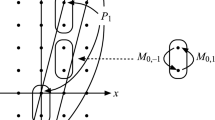Abstract
Viruses with icosahedral capsids, which form the largest class of all viruses and contain a number of important human pathogens, can be modelled via suitable icosahedrally invariant finite subsets of icosahedral 3D quasicrystals. We combine concepts from the theory of 3D quasicrystals, and from the theory of structural phase transformations in crystalline solids, to give a framework for the study of the structural transitions occurring in icosahedral viral capsids during maturation or infection. As 3D quasicrystals are in a one-to-one correspondence with suitable subsets of 6D icosahedral Bravais lattices, we study systematically the 6D-analogs of the classical Bain deformations in 3D, characterized by minimal symmetry loss at intermediate configurations, and use this information to infer putative viral-capsid transition paths in 3D via the cut-and-project method used for the construction of quasicrystals. We apply our approach to the Cowpea Chlorotic Mottle virus (CCMV) and show that the putative transition path between the experimentally observed initial and final CCMV structures is most likely to preserve one threefold axis. Our procedure suggests a general method for the investigation and prediction of symmetry constraints on the capsids of icosahedral viruses during structural transitions, and thus provides insights into the mechanisms underlying structural transitions of these pathogens.
Similar content being viewed by others
References
Alippi P, Marcus PM, Scheffler M (1997) Strained tetragonal states and Bain paths in metals. Phys Rev Lett 78(20): 3892–3895
Bain EC (1924) The nature of martensite. Trans AIME 70: 25–35
Bhattacharya K, Conti S, Zanzotto G, Zimmer J (2004) Crystal symmetry and the reversibility of martensitic transformations. Nature 428: 55–59
Boyer LL, Kaxiras E, Feldman JL, Broughton JQ, Mehl MJ (1991) New low-energy crystal structure for silicon. Phys Rev Lett 67: 715–718
Boyer LL (1989) Magic strains in face-centered and body-centered cubic lattices. Acta Cryst A 45: fc29–fc32
Capillas C, Perez-Mato JM, Aroyo MI (2007) Maximal symmetry transition paths for reconstructive phase transitions. J Phys Condens Matter 19: 27–5203
Christian JW (2002) The theory of transformations in metals and alloys. Pergamon Press, Oxford
Conway JF, Wikoff WR, Cheng N, Duda RL, Hendrix RW, Johnson JE, Steven AC (2001) Virus maturation involving large subunit rotations and local refolding. Science 292(5517): 744–748
Guérin T, Bruinsma RF (2007) Theory of conformational transitions of viral shells. Phys Rev E 76: 061911
Janner A (2005) Strongly correlated structure of axial-symmetric proteins. I. orthorhombic, tetragonal, trigonal and hexagonal symmetries. Acta Cryst D 61: 247–255
Janner A (2006) Crystallographic structural organization of human rhinovirus serotype 16, 14, 3, 2 and 1A. Acta Cryst A 62: 270–286
Katz A (1989) Some local properties of the 3D Penrose tilings. In: Jaric MV (ed) Introduction to the mathematics of quasicrystals. Academic Press, Dublin, pp 147–182
Kaxiras E, Boyer LL (1992) Exploring the structure of solids through magic strains: prediction of a new metallic phase of Si. Modelling Simul Mater Sci Eng 1: 91–100
Keef T, Wardman J, Ranson NA, Stockley PG, Twarock R (2011) Viruses measure up to mathematical prediction—3D geometry imposes fundamental constraints on the structures of simple viruses (submitted)
Keef T, Twarock R (2010) Beyond quasi-equivalence: new insights into viral architecture via affine extended symmetry groups. In: Stockley PG, Twarock R (eds) Emerging topics in physical virology. Imperial College Press, London, pp 59–83
Keef T, Twarock R (2009) Affine extensions of the icosahedral group with applications to the 3D organisation of simple viruses. J Math Biol 59: 287–313
Klug WS, Bruinsma RF, Michel JP, Knobler CM, Ivanovska IL, Schmidt CF, Wuite GJL (2006) Failure of viral shells. Phys Rev Lett 97: 228101
Levitov LS, Rhyner J (1988) Crystallography of quasicrystals; application to icosahedral symmetry. J Phys 49: 1835–1849
Mehl MJ, Aguayo A, Boyer LL (2004) Absence of metastable states in strained monatomic cubic crystals. Phys Rev B 70: 014105
Pitteri M, Zanzotto G (1998) Beyond space groups: the arithmetic symmetry of deformable multilattices. Acta Cryst A 54: 359–373
Pitteri M, Zanzotto G (2002) Continuum models for phase transitions and twinning in crystals. CRC/Chapman and Hall, London
Rim JE, Ma L, Bruinsma RF, Klug WS (2010) Phase transitions in viral capsid maturation (in preparation)
Robinson IK, Harrison SC (1982) Structure of the expanded state of Tomato Bushy Stunt Virus. Nature 297: 563–568
Senechal M (1995) Quasicrystals and geometry. Cambridge University Press, Cambridge
Sherman MB, Guenther RH, Tama F, Sit TL, Brooks CL III, Mikhailov AM, Orlova EV, Baker TS, Lommel SA (2006) Removal of divalent cations induces structural transitions in Red Clover Necrotic Mosaic Virus, revealing a potential mechanism for RNA release. J Virol 80(21): 10395–10406
Sowa H, Koch E (2002) Group-theoretical and geometrical considerations of the phase transition between the high-temperature polymorphs of quartz and tridymite. Acta Cryst A 58: 327–333
Tama F, Brooks CL III (2002) The mechanism and pathway of pH-induced swelling in Cowpea Chlorotic Mottle Virus. J Mol Biol 318: 733–747
Tama F, Brooks CL III (2005) Diversity and identity of mechanical properties of icosahedral viral capsids studies with elastic network normal mode analysis. J Mol Biol 345: 299–314
Toledano P, Dmitriev V (1996) Reconstructive phase transitions. World Scientific Publishing Company, Singapore
Wayman CM (1964) Introduction to the crystallography of martensite transformations. Macmillan, New York
Wijnands F (1991) An algorithm to find generators for the normalizer of an n-3D crystalographic point group in \({GL(n,{\mathbb Z})}\) . J Phys A Math Gen 24: 5703–5720
Author information
Authors and Affiliations
Corresponding author
Rights and permissions
About this article
Cite this article
Indelicato, G., Cermelli, P., Salthouse, D.G. et al. A crystallographic approach to structural transitions in icosahedral viruses. J. Math. Biol. 64, 745–773 (2012). https://doi.org/10.1007/s00285-011-0425-5
Received:
Revised:
Published:
Issue Date:
DOI: https://doi.org/10.1007/s00285-011-0425-5




